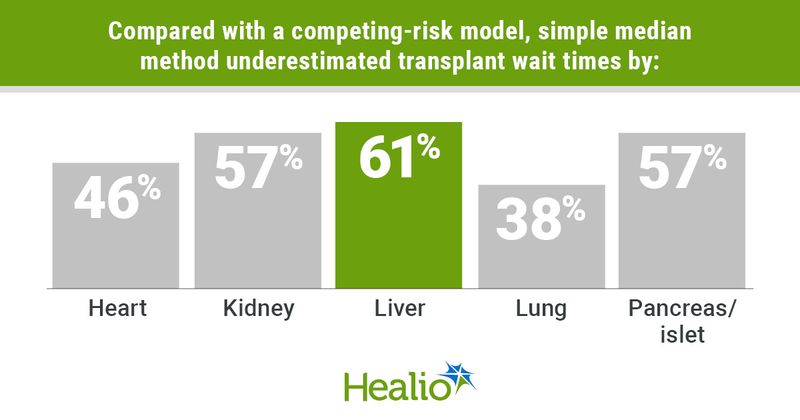Competing-risk model provides more accurate estimate of transplant waiting time
Key takeaways:
- Simple median waiting times accounting only for transplant recipients underestimated waiting times by 38% to 61%.
- The Kaplan-Meier estimator also underestimated waiting times by 2% to 12%.
A simple median waiting time that did not account for censoring, death and other competing events underestimated time to organ transplantation by up to 61% compared with a competing-risk model, according to a study conducted in Switzerland.
“It has been recognized that relying on the median waiting time among recipients could be misleading,” Simon Schwab, MSc, PhD, a senior statistician at Swisstransplant, and colleagues wrote in JAMA Network Open. “Two studies that primarily considered kidney recipients recommended censoring competing events and using the Kaplan-Meier estimator or a Cox proportional hazards model. However, the Kaplan-Meier approach may result in an upward bias in the cumulative incidence of transplantation and should be reconsidered in favor of competing-risk methods.”

Seeking to better estimate how long candidates wait for organ transplant in Switzerland, Schwab and colleagues conducted the retrospective Waitlist Analysis in Transplantation study of 3,643 transplant candidates (median age, 56 years; 66.6% men) waitlisted for organ allocation between January 2018 and December 2023.
The researchers applied a competing-risk multistate model using the Aalen-Johansen estimator to investigate time to transplantation, death or delisting and compared outcome probabilities with the simple median waiting time and Kaplan-Meier method with censoring for competing events. Studied transplant programs included the heart, kidney, liver, lungs and pancreas and/or islet.
At baseline, 3% of candidates were listed for multiorgan transplantation, most of which were kidney and pancreas (66.1%) and liver and kidney (23.9%).
After a median follow-up of 2.93 years, the researchers reported there were 2,035 transplants, 327 deaths and 204 delistings. The probability for transplantation exceeded 50% within the first 2 years of listing for all transplant programs except kidney, while the highest probability of death within the first year occurred with liver (12%), heart (8%), lungs (7%) kidney (1%) and pancreas and/or islet (1%). The researchers noted that delisting was the least frequent outcome, occurring mostly with liver (11%) and heart (7%) programs, by 4 years.
Results also demonstrated median times to transplantation of 0.91 (95% CI, 0.83-1.07) years for heart, 3.1 (95% CI, 2.57-3.77) for kidney, 1.32 (95% CI, 0.76-1.55) for liver, 0.8 (95% CI, 0.37-1.12) for lung and 1.62 (95% CI, 0.91-2.17) for pancreas and/or islet. In comparison, among only those undergoing transplantation, the simple median method underestimated wait times by 46%, 57%, 61%, 38% and 57%, respectively, as did the Kaplan-Meier method by 7%, 5%, 12%, 6% and 2%.
“Findings of this cohort study suggest that understanding the waiting list as a competing-risk multistate model can appropriately inform patients and clinicians about average expected waiting times and support the monitoring of national transplant programs,” Schwab and colleagues wrote. “Competing-risk methods should be preferred over the simple median among recipients or Kaplan-Meier to avoid bias and overoptimistic estimates.”
